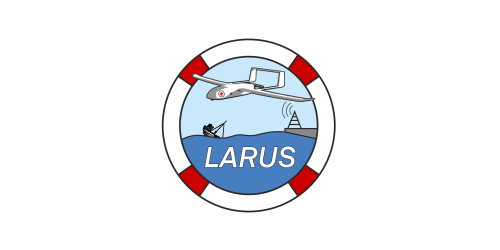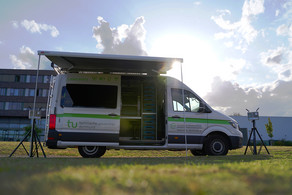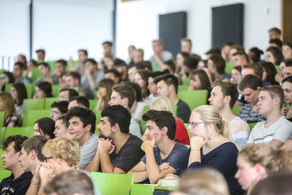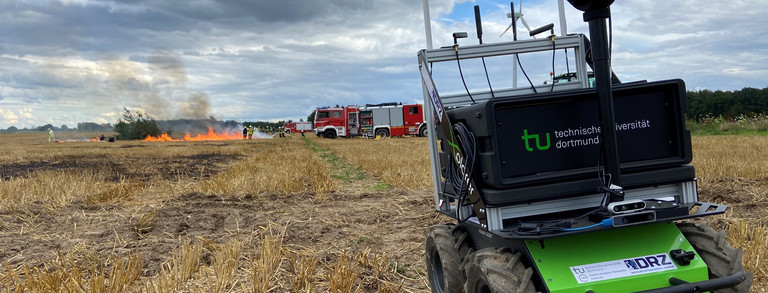LARUS
For ships in distress at sea every minute counts. However, rescuers often receive imprecise emergency calls that do not contain all information required for an efficient deployment. This challenge applies in particular to rescue missions for persons in the water or small vehicles that do not carry locating devices. The LARUS project aims to develop an automated system that supports search and rescue of persons in distress at sea.
Project duration: 15.10.2016 - 14.10.2019

In the LARUS project, we aim to provide fast mission support through deployment of an unmanned aerial system (UAS). These systems can be used
- to decrease on-scene arrival time,
- to localize persons in distress and objects in the water,
- to identify and observe the situtation,
- and to provide communication resources (mobile relay).
The project develops the basis for an unmanned, automated search and localization system, that is fully integrated into civil airspace, to be deployed by the German Maritime Search and Rescue Service. Its various sensors and communication interfaces enable the UAS to be used in additional scenarios like offshore industry and disaster management.
LARUS is funded by the German Federal Ministry of Education and Research under grant number 13N14133.
Further information:
News
BMBF-Project coordinated by CNI receives nomination for international award
We are pleased to announce that the LARUS project (funded by the german Federal Ministry of Education and Research and coordinated by the…
LARUS project coordinated by CNI successfully tests unmanned aircraft system over the Baltic Sea to support maritime search and rescue
Three-year research project to improve communication and data exchange at sea brings important findings to practice.
Over the Baltic Sea, the German…
BMBF State Secretary Rachel catches up on the LARUS-Project
At the BMBF-Innovationsforum "Zivile Sicherheit", which took place on June 19 and 20, 2018 in Berlin, the joint research project LARUS, which is…
Sucessful Initiation of Unmanned Aerial Systems for the Support of See Rescue Operations
In the case of the detection and rescue of shipwrecked people, every minute counts. Often, the voice-radio-based distress message is imprecise and…
5G-Initiative for Germany - TU Dortmund Is a Part of It
5G-Initiative for Germany - TU Dortmund is a part of it: The Federal Minister for Traffic and Digital Infrastructure has started an initiative, that…
Publications
Reliable Long-Range Multi-Link Communication for Unmanned Search and Rescue Aircraft Systems in Beyond Visual Line of Sight Operation
J. Güldenring, P. Gorczak, F. Eckermann, M. Patchou, J. Tiemann, F. Kurtz, C. Wietfeld
In Drones, MDPI, vol. 4, no. 2, May 2020
Unmanned Aerial Vehicles in Logistics: Efficiency Gains and Communication Performance of Hybrid Combinations of Ground and Aerial Vehicles
M. Patchou, B. Sliwa, C. Wietfeld
In IEEE Vehicular Networking Conference (VNC) 2019, Los Angeles, USA, December 2019.
Heterogeneous Multilink Aggregation for Reliable UAV Communication in Maritime Search and Rescue Missions
J. Güldenring, L. Koring, P. Gorczak, C. Wietfeld
In 15th IEEE International Conference on Wireless and Mobile Computing, Networking and…
Experimental 5G mmWave Beam Tracking Testbed for Evaluation of Vehicular Communications
K. Heimann, J. Tiemann, D. Yolchyan, C. Wietfeld
In IEEE 2nd 5G World Forum (5GWF) (WF-5G'19), September 2019.
Robust Cellular Communications for Unmanned Aerial Vehicles in Maritime Search and Rescue
P. Gorczak, C. Bektas, F. Kurtz, T. Lübcke, C. Wietfeld
In IEEE International Symposium on Safety, Security, and Rescue Robotics (SSRR), IEEE
Software-Defined End-to-End Evaluation Platform for Quality of Service in Non-Standalone 5G Systems
K. Heimann, P. Gorczak, C. Bektas, F. Girke, C. Wietfeld
In 2019 Annual IEEE International Systems Conference (SysCon), Orlando, Florida, USA
Supporting Maritime Search and Rescue Missions through UAS-based Wireless Localization
J. Tiemann, O. Feldmeier, C. Wietfeld
In IEEE Global Communications Conference Workshops (GLOBECOM Workshops), Abu Dhabi, United Arab Emirates, 2018
tinyLTE: Lightweight, Ad Hoc Deployable Cellular Network for Vehicular Communication
F. Eckermann, P. Gorczak, C. Wietfeld,
In IEEE Vehicular Technology Conference (VTC-Spring), June 2018.
On the Potential of 5G mmWave Pencil Beam Antennas for UAV Communications: An Experimental Evaluation
K. Heimann, J. Tiemann, S. Böcker, C. Wietfeld,
In 22nd International ITG Workshop on Smart Antennas, VDE Verlag GMBH Berlin und Offenbach, Mach…





